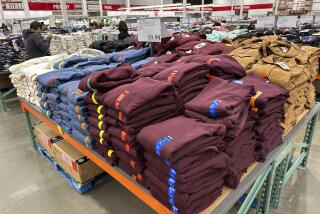Retail Sales Growth at 30-Year Low : Stores: 1991 saw only a 0.7% rise in business, the worst showing since 1961.
WASHINGTON — Retail sales rose only 0.7% in 1991, the smallest increase in three decades, as a stubborn recession cut into traditional Christmas season sales, the government reported Tuesday.
Seasonally adjusted sales actually fell in December after declines the two previous months, reflecting growing consumer anxiety about the state of the economy late in the year.
Retailers have now suffered through three consecutive dismal holiday seasons, the period on which many stores and businesses count for half their annual sales and profits.
December sales dropped 0.4% to a seasonally adjusted $151.2 billion, compared to $151.7 billion in November.
Furthermore, the department’s calculations of November sales were revised sharply lower to a decline of 0.5% from October, instead of the previously reported 0.3% increase. October’s sales, originally reported as flat, were reported to have slipped 0.1%.
The 0.7% gain in 1991--to sales of $1.8 trillion--represented the worst year-to-year performance since a 0.1% decline in 1961.
By contrast, sales on a year-to-year basis rose 3.8% in 1990, 6% in 1989 and 6.8% in 1988.
White House press secretary Marlin Fitzwater said the sales figures “indicate a very cautious consumer” as the year begins. “We expect a recovery in retail sales this year as the significant monetary easing by the Federal Reserve Board in late 1991 works its way through the economy.”
The bad news did not take private economists by surprise.
“These numbers are right on target: They’re lousy,” said Donald Straszheim, chief economist for Merrill Lynch in New York.
“We had heard about the blizzard of layoff announcements in the fourth quarter . . . and then fragmentary reports from large chain stores (that sales) were no good,” Straszheim said. “We knew retail sales would be off and that consumers would hold on tightly to their wallets.”
Because retail sales account for one-third of the nation’s economic activity, lack of consumer participation will be a stumbling block to any recovery.
The “process that got us to this point has been developing for years,” said Straszheim, “and consumer spending is going to be weak for a long, long time to come.”
The problem, according to Straszheim, is that consumers “simply have less money for discretionary purchases.”
The Commerce Department report showed that department store sales fell 2.2% last month after edging up 0.6% in November. Apparel sales were down 0.7% after remaining flat a month earlier.
Grocery store sales were up 0.3% after falling 0.4% the previous month; drugstore sales also rose 0.3% after posting a 0.6% loss in November.
Cynthia Latter, senior financial economist for DRI/McGraw-Hill in Lexington, Mass., said consumer confidence will need to be buoyed by continued low interest rates and job growth.
“I think the sales figures are a cause for worry,” Latter said. “Growth in the fourth quarter (of ‘91) will be flat at best, and the first quarter of this year will be bleak.”
Slow Month Ends a Flat Year for Retail Sales Sales for December Seasonally adjusted, billions of dollars Dec., ‘91: $151.2 Nov., ‘91: $151.7 Dec., ‘90: $149.8 Annual Sales, 1980-91 Annual totals, trillions of dollars 1991: $1.82 trillion 1980: $0.96 trillion Source: Commerce Department
More to Read
Inside the business of entertainment
The Wide Shot brings you news, analysis and insights on everything from streaming wars to production — and what it all means for the future.
You may occasionally receive promotional content from the Los Angeles Times.










